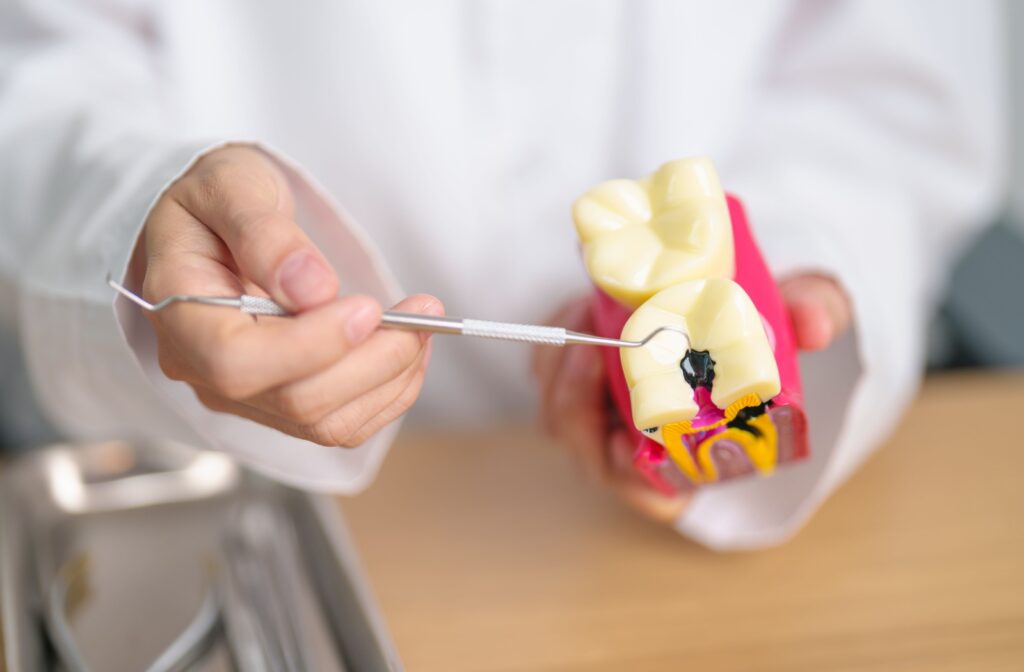Tooth decay is a common problem that affects millions of people worldwide. Reversing tooth decay may be possible in its earliest progression through remineralization, but a dentist’s intervention is necessary once the decay progresses through the enamel into dentin.
Unfortunately, many people do not notice the beginning stages of demineralization, which can lead to tooth decay and cavities. This highlights the importance of regular dental exams and professional cleanings.
Understanding Tooth Decay
Tooth decay is a gradual process that begins with acids attacking your tooth’s enamel, leading to demineralization. Consuming carbohydrate foods causes the bacteria in the mouth to produce lactic acid. If this process continues, it eventually leads to cavities that require extensive repair, such as a filling or root canal treatment if the pulp becomes involved.
One interesting thing about tooth decay is how it has increased in prevalence throughout history. Upon discovering human skeletal remains buried in the Al Khuday cemetery in Sudan 2000 years ago, researchers learned that those who ate the purple nutsedge weed had teeth that were surprisingly resistant to tooth decay and other dental problems. Also, diets at this time did not include refined sugars and starches.
This is not to say that we should go out and find this particular grass to chew on. But its antibacterial properties are likely what led to healthier teeth and less buildup of bacterial plaque.
Progression of Tooth Decay
There are several steps in tooth decay’s progression, beginning with initial demineralization and eventually leading to pulp damage when left untreated.
Initial Demineralization
White spots on the enamel characterize the initial stage of demineralization. Acid attack causes the enamel to lose its minerals, but the damage is reversible with proper care during the initial stages
Enamel Decay
The decay eventually penetrates deeper into the enamel. Brown spots may appear, and the enamel starts to break down. Professional intervention is usually necessary to halt the progression.
Dentin Decay
Once the decay reaches the dentin, an individual will likely experience pain and sensitivity. The tooth structure weakens, making it more susceptible to further damage. At this stage, immediate dental treatment is required to prevent the decay from penetrating the less mineralized layer of dentin and possibly reaching the pulp of the tooth.
Pulp Damage
If the decay invades the pulp, it will lead to severe pain and infection. Root canal therapy or even tooth extraction may be necessary. This only occurs when there is a lack of early preventive or restorative measures! Prevention and early detection will avoid this advanced stage of infection and eliminate the need for drastic treatment options.
Reversing Tooth Decay
The good news is that tooth decay can often be reversed in its early stages through remineralization.
The effectiveness of remineralization techniques depends on the stage of decay and individual oral care habits. For instance, regular brushing, flossing, and fluoride treatments can successfully prevent or reverse early enamel demineralization. Consulting your dentist for personalized advice and treatment options is crucial in effective management of tooth decay.
Dental Remineralization
Remineralization is the natural repair process where minerals like calcium and phosphate are redeposited in the enamel. Saliva is crucial in this process because it contains minerals that help neutralize acids and promote remineralization. Various products and treatments are available to enhance this natural process.
Fluoride Toothpaste
- Fluoride helps strengthen enamel and promotes demineralization.
- Brushing twice daily with fluoride toothpaste and regular flossing can significantly reduce the risk of decay.
- It is a simple yet effective way to enhance your oral hygiene routine.
Fluoride Mouthwash
- Rinsing with fluoride mouthwash provides additional protection.
- It reaches areas that brushing may miss, promoting comprehensive care.
- Incorporating this step into your routine can boost the effectiveness of demineralization.
Dietary Changes
- Reducing sugar intake minimizes acid attacks on enamel.
- Consuming calcium-rich dairy products supports strong enamel.
- A balanced diet and fluoride availability contribute to overall oral health and remineralization.
Professional Treatments for Treating Tooth Decay
While remineralization techniques like fluoride toothpaste or mouthwash can be effective for early-stage decay, professional treatments are essential for more advanced cases. We offer various ways to halt and reverse tooth decay to provide comprehensive care and protection.
Fluoride Treatments
Fluoride treatments involve applying a concentrated fluoride gel or varnish to the teeth. This strengthens the enamel, making it more resistant to acid attacks. Fluoride treatments are particularly beneficial for individuals at high risk of decay, providing an extra layer of protection.
Dental Sealants
Dental sealants are thin, protective coatings applied to the chewing surfaces of molars and premolars. They act as a barrier, preventing food particles and bacteria from settling into the grooves and pits of the teeth. Sealants are especially effective for children and teenagers, reducing the risk of cavities in vulnerable areas.
Good Oral Hygiene Practices & Professional Intervention
Maintaining good oral hygiene is fundamental in preventing and reversing decay. Prevention is always preferred over treatment. Using fluoridated toothpaste and mouthwash can help prevent tooth decay. It can even help repair minor damage before it turns into a bigger issue.
More importantly, regular dental exams can help spot tooth decay during its early stages making it easier to treat. Similarly, regular dental cleanings can significantly prevent tooth decay from developing. Call us at Kensington Dental Care today to book an appointment if you are due for an exam or notice signs of tooth decay.










